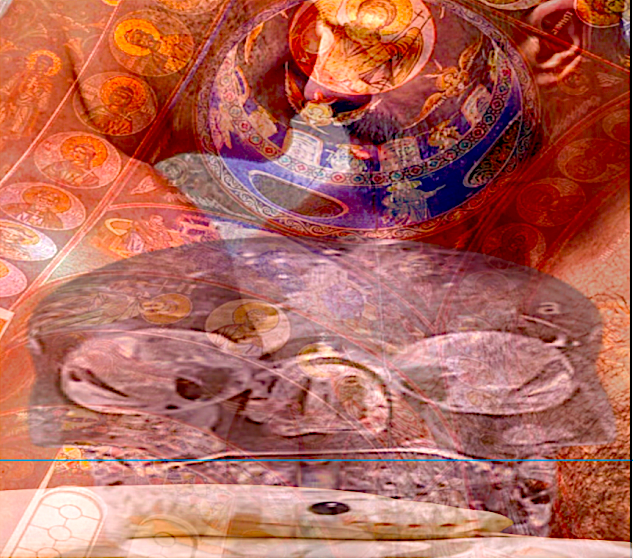The current Collapse of Meaning in Contemporary Art: Reflecting on Lost Souls and Its Antidotes
Contemporary art industry seemingly dominated by self-centred, self-serving artists, creating uninspired works for a similarly uninspired public.

Contemporary art, once a sphere of profound insight and daring innovation, is now often embroiled in a crisis of meaning. At its core lies an industry seemingly dominated by self-centred, self-serving artists, creating uninspired works for a similarly uninspired public. However, this does not need to be the case. Artists like Claude Edwin Theriault challenge the status quo by infusing their work with purpose and therapeutic value, demonstrating that art can still be a beacon of creativity and healing.
This article explores the collapse of meaning in contemporary art, the influence of self-serving cliques, and how artists like Theriault turn the tide by offering art that resonates deeply with its audience.
The Collapse of Meaning: A Reflection of Society’s Cyclic Saeculum Ennui
Modern art galleries brim with pieces that seem to prioritize posturing over substance. Slick, trendy works often lack emotional depth, inviting criticism for their failure to connect meaningfully. Self-centred artists, driven more by their social capital than creative fervour, churn out uninspired works to please gallery owners or adhere to fleeting trends.
Audiences, often intimidated by the exclusivity of the contemporary art world, accept these works without question, assuming their merit lies in the artist’s reputation rather than the work itself. This echo chamber perpetuates a vicious cycle: dull art for a disengaged audience, both complicit in a culture of mediocrity. As a result, art that once served as a mirror to the soul has become a reflection of cultural stagnation.
Yet, history shows us this phenomenon is not new. Van Gogh, who dared to use bold, unconventional colours, was rejected by the art salons of his time. Similarly, Picasso’s cubist work initially faced resistance from gallery owners who did not see its revolutionary potential. These examples remind us that greatness in art often comes from challenging norms—not succumbing to them.
The Rise of the Connected Poser Artists
In today’s art scene, "connected poser artists" thrive by aligning with industry insiders and cultivating a veneer of creativity, often at the expense of genuine innovation. These individuals are less concerned with the soul of their art and more focused on maintaining relevance within elite circles. Their work may be glossy, expensive, and impeccably curated, but it often lacks the essence that makes art transformative.
The art world’s obsession with exclusivity and trendiness exacerbates this issue. Niche artists buy into established paradigms, presenting predictable works that cater to pre-approved aesthetics. This transactional approach reduces art to a commodity, stripping it of the raw, unfiltered emotion that defines true creativity.
Meanwhile, the public plays along, hesitant to critique for fear of being labelled unsophisticated. Art becomes a language of the elite, unintelligible to those not in the know. The disconnect grows, leaving the masses alienated and the art world a shadow of its former self.
Claude Edwin Theriault: Turning the Tables on Art's Status Quo and 6.2 million dollar banana duct taped to a wall to get that 15-minute fame
Claude Edwin Theriault emerges as a revolutionary force in this creative stagnation environment. Unlike the many artists who buy their way into creative recognition, Theriault is a creative dynamo who tirelessly works at his craft, emphasizing art’s therapeutic value as its unique selling point. For Theriault, art is more than an aesthetic statement; it is a tool for healing, self-discovery, and connection.
Theriault’s approach starkly contrasts the contemporary art world's superficiality. He redefines what art can achieve by creating pieces that prioritize emotional resonance and utility. His work appeals to collectors and individuals seeking solace and inspiration—a stark departure from the disconnected poser art that dominates today’s galleries.
His journey echoes the struggles of historical greats like Van Gogh and Picasso, who faced rejection for daring to defy convention. Theriault’s dedication proves thatartists can thrive by staying true to their vision and values even in a system designed to reward mediocrity. He turns the tables on the corrupt brick-and-mortar art industry, showing that authentic creativity still holds power.

Art as a Demanding Desire—and Anything You Can Get Away With in a Lost Direction Culture
Art’s enduring allure lies in its complexity. It is at once a demanding desire, pushing both artists and audiences to confront the depths of human experience and a platform for experimentation where the boldest ideas can thrive. Yet, as history and the present day demonstrate, the art world is also a space where cliques and politics often determine success.
The “La Clique du Jour” phenomenon—where gatekeepers dismiss visionary works in favour of safe, fashionable choices—remains a barrier for many artists. However, for those willing to persevere, the rewards are profound. Art has the power to inspire, challenge, and heal, provided it is approached with sincerity and passion.
The collapse of meaning in contemporary art is not inevitable. Artists like Claude Edwin Theriault prove that by rejecting superficiality and embracing the transformative potential of their craft, they can break free from the constraints of the status quo. In doing so, they remind us that art, at its best, reflects the human spirit—messy, beautiful, and endlessly inspiring.

Reclaiming the Soul of Contemporary Art to begin anew
The contemporary art world may be mired in mediocrity, but it is not beyond redemption. By challenging the superficial norms and embracing art’s deeper purpose, artists and audiences alike can restore meaning to this vital cultural sphere. Claude Edwin Theriault’s work serves as a beacon in this effort, illustrating how creativity, combined with purpose, can transcend the limitations of a flawed system.
Let us remember the lessons of history. Once dismissed by their contemporaries, Van Gogh and Picasso now stand as innovation icons. Similarly, those who dare to defy convention and reconnect with art’s true essence will define the art of tomorrow. For in art, as in life, meaning is not a given—it is something we must strive to create.

